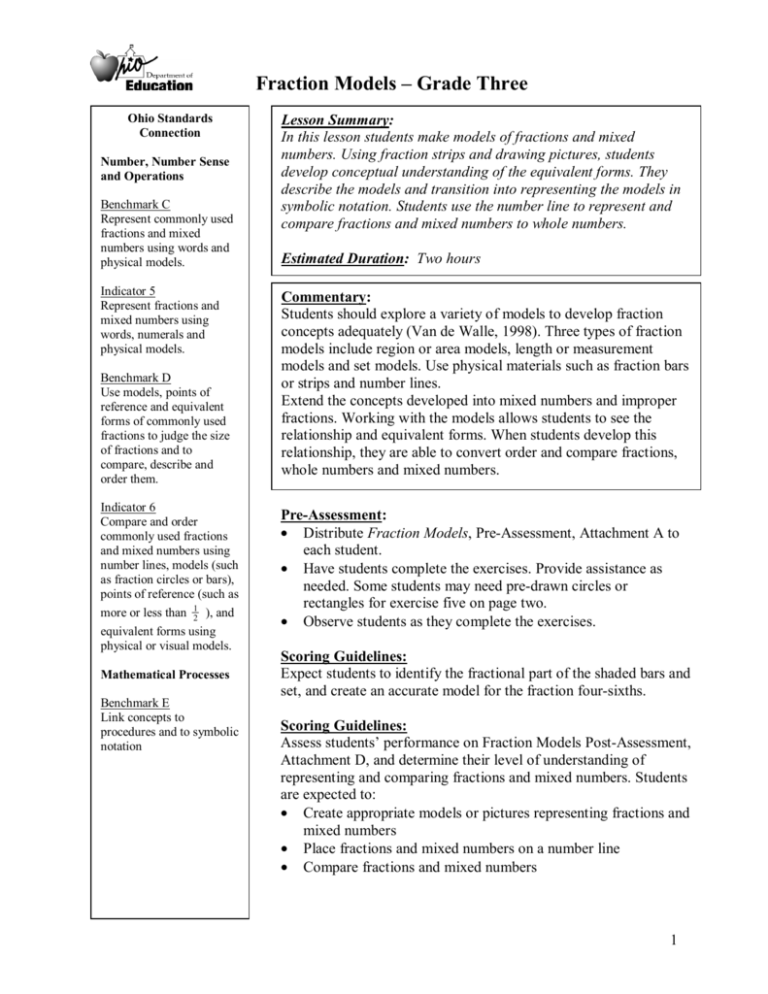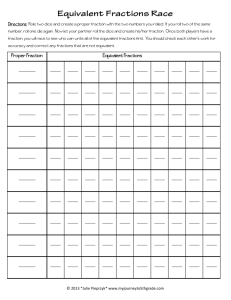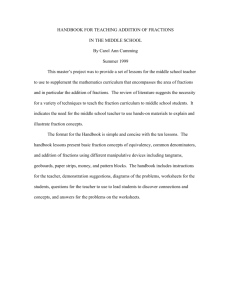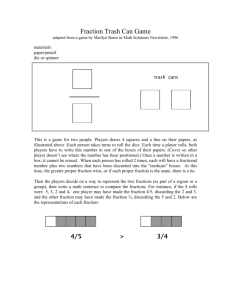Fraction Models – Grade Three - ODE IMS
advertisement

Fraction Models – Grade Three Ohio Standards Connection Number, Number Sense and Operations Benchmark C Represent commonly used fractions and mixed numbers using words and physical models. Indicator 5 Represent fractions and mixed numbers using words, numerals and physical models. Benchmark D Use models, points of reference and equivalent forms of commonly used fractions to judge the size of fractions and to compare, describe and order them. Indicator 6 Compare and order commonly used fractions and mixed numbers using number lines, models (such as fraction circles or bars), points of reference (such as more or less than 12 ), and equivalent forms using physical or visual models. Mathematical Processes Benchmark E Link concepts to procedures and to symbolic notation Lesson Summary: In this lesson students make models of fractions and mixed numbers. Using fraction strips and drawing pictures, students develop conceptual understanding of the equivalent forms. They describe the models and transition into representing the models in symbolic notation. Students use the number line to represent and compare fractions and mixed numbers to whole numbers. Estimated Duration: Two hours Commentary: Students should explore a variety of models to develop fraction concepts adequately (Van de Walle, 1998). Three types of fraction models include region or area models, length or measurement models and set models. Use physical materials such as fraction bars or strips and number lines. Extend the concepts developed into mixed numbers and improper fractions. Working with the models allows students to see the relationship and equivalent forms. When students develop this relationship, they are able to convert order and compare fractions, whole numbers and mixed numbers. Pre-Assessment: • Distribute Fraction Models, Pre-Assessment, Attachment A to each student. • Have students complete the exercises. Provide assistance as needed. Some students may need pre-drawn circles or rectangles for exercise five on page two. • Observe students as they complete the exercises. Scoring Guidelines: Expect students to identify the fractional part of the shaded bars and set, and create an accurate model for the fraction four-sixths. Scoring Guidelines: Assess students’ performance on Fraction Models Post-Assessment, Attachment D, and determine their level of understanding of representing and comparing fractions and mixed numbers. Students are expected to: • Create appropriate models or pictures representing fractions and mixed numbers • Place fractions and mixed numbers on a number line • Compare fractions and mixed numbers 1 Fraction Models – Grade Three Part One 1. Have students create a set of fraction strips. Give each student 6 strips of white paper (one inch wide by 11 or 12 inches long, depending on the paper used). a. Have students take one strip and fold in so the ends of the strip touch. Have them draw a line on the fold. Ask how many sections are on the strip (2). Have them describe the fractional part of each section (one-half). Direct the students to write “one-half” on each part of the strip. b. Complete creating strips for thirds, fourths, sixths and eights. Have students label each section. Label one strip as the “one” or “one whole”. 2. Present the scenario to students. Three friends each ordered a pizza for dinner. Mary ate one-half of her pizza. Joe ate twothirds of his pizza. Hanna ate three-fourths of her pizza. Find which friend ate more pizza. a. Have students select the appropriate fraction strips to use to solve this situation (halves, thirds and fourths). b. Have students make models of each fraction using the strip. Have them fold the part of the strip not needed under, so only the fractional part needed is seen. c. Have students compare the lengths of the strips and ask questions to determine who ate more. • Which is fraction strip is longer? • Which is fraction strip is shorter? • Which fraction is larger? • Who ate the least amount of pizza? • Place the strips in order from largest to smallest. d. Have students draw representations of models in their journal. Model how to draw and shade fraction bars. e. Model for students how to write the fractions with numerals. Explain the meaning of the numerator or denominator. The bottom number represents the total number of parts. The top number represents the number of parts identified. Have students write the three fractions for the scenario. Instructional Tip: Delay introducing the formal terminology for numerator and denominator. Students first need to understand the concept of part and whole in the symbolic notation of a fraction. Introducing vocabulary too early can cause confusion and the development of misconceptions. f. Have students use symbols to write comparisons with fractions, if they have learned this prior to the lesson. Otherwise, wait until students can compare, then introduce the symbols. 3. Present another problem situation. Three friends each bought a Crunchy chocolate bar. Will ate four-sixths of his bar. Tamara ate two-thirds of her bar. Scottie ate two-eights of his bar. Determine who ate more. a. Direct the students to make model of the fractions using the fraction strips. b. Have them draw pictures of each model in a journal. Then, have students share to compare their drawings and make corrections as needed. c. Have them compare to determine which friend ate the most of their candy bar. 2 Fraction Models – Grade Three 4. 5. 6. 7. d. Ask questions about the fractions, • How would you write the fraction representing the part of the candy bar Will ate? Tamara ate? Scottie ate? • Compare the parts of the candy bar that Will and Tamara ate. • Did each friend eat more than or less than one-half of the candy bar? (Will and Tamara more than, Scottie less than) • Can you find another strip to make a fraction that is the same as Scottie’s? Have students make a model for one-half using the fraction strips. Have students make models that are the same as one-half using other strips. Tell the students to draw pictures of the models in journals and write the fractions using numbers. Students who complete the task early can write comparative statements in words or using symbols. Allow students to share the models they created. Have students make models of fractions that are smaller than one-half. Tell the students to draw pictures of the models in journals and write the fractions using numbers. Students who complete the task early can write comparative statements in words or using symbols. Allow students to share the models they created. Place the representations drawn by students, which are equal to, greater than and less than one-half, on a bulletin board. Part Two Prepare an overhead transparency of Models for Scenarios, Attachment C. Use the transparency to model creating pictures of mixed numbers and improper fractions for the scenarios in procedures 11-13. 8. Discuss fractions that represent one-whole. Ask questions such as, • A pizza is cut into eight slices. How many slices make a whole pizza? How would you write one-whole pizza as a fraction? Why? What if a whole pizza was cut into twelve slices? • A bag contained ten red marbles. What fraction represents the part of red marbles in the bag? Why? Explain that fractions which are equal to one-whole have the same numerator and denominator. 9. Have students take out their fraction strips. Ask them to determine the number of thirds in a strip. Students should count three sections on the thirds strip. Have students write the fraction to represent one-whole using thirds. Complete this task with other fraction strips and informally assess progress toward identifying fractions which are equal to one-whole. 10. Pair students and have them cut the fraction strips into the appropriate sections (on the folds). 11. Introduce fractions larger than one. a. Have the pairs count out seven fourths. Ask them if seven fourths is greater than one whole or less than a whole (greater than). b. Tell students to use the fraction strips to show that seven fourths is greater than onewhole. Models should include combining four fourths to make one whole strip and combining the remaining three fourths 7 c. Have the students write the fraction for seven fourths ( ). 4 3 Fraction Models – Grade Three d. Ask students for other ways to describe the fraction by using the model. (One and threefourths, one plus three-fourths) 12. Have students count our eleven sixths and determine if it is greater than or less then one whole. 11 a. Have them write a fraction for eleven sixths ( ). 6 b. Have them create a model to show that eleven-sixths is greater than one. Observe students as they combine. Ask students how many parts belong in one whole, if they appear to not understand the task. c. Select a few partners to share the model with the class and describe the model in a different way (one and five-sixths or one plus five-sixths). Models should show six-sixths making one whole and five-sixths combined to make a part of another whole. d. Introduce the term mixed number. Tell students when a whole number and a fraction are used to describe an amount; it is called a mixed number. 13. Continue having students create models greater than one with the fraction strips. Combine three or four students into groups to make numbers larger than two. For example, have a group of three students combine thirteen fifths and write as a fraction and a whole number. Include having the students make models of whole numbers. Use real-world contexts such as, “What is another way to describe the amount of pizza? There are 19 slices of pizza. Each slice is one-eight of a pizza.” 14. Assign Finding Mixed Numbers, Attachment D. Observe students as they work and provide assistance as appropriate. Encourage the use of fraction models and pictures to help complete the tasks and reinforce the concepts. Part Three 15. Present scenarios and have students use fraction models to represent mixed numbers and find the equivalent improper fraction. The teacher said that there were two and one-eighth pizzas left after lunch. The teacher wants to know if there are enough slices to give to each student. Each pizza was cut into eight slices. There are 15 students in the class. a. Place students into groups of four and have them take out the fraction models representing eighths. Tell them to build a model for two and one-eighth. Observe the models students build. Assist students who use an incorrect number of eighths to make a whole and guide them to understand that eight-eighths is equal to one-whole. b. Select groups to share their models and response to the situation. Ask for the number of eighths in two and one-eighth. 16. Display Mixed Number Models, Attachment E on the overhead projector. Ask the students to determine the number of sections for each representation and write the improper fraction. 17. Rewrite the mixed numbers from Mixed Number Models, Attachment E, in different ways, if students are ready. For example, in the first drawing two and one-half can be written as one and three-halves. This helps students develop deep understanding and provides a foundation for when students learn to subtract mixed numbers. 18. Provide additional practice on the board or from another source. Encourage students to use the fraction models and pictures to support their work. 4 Fraction Models – Grade Three 19. Place a number line on the board or overhead. Place the whole numbers on the number line. Ask students to give examples of fractions that are equivalent to the whole numbers. 20. Write mixed numbers and improper fractions on the board. Have students work in pairs and place the mixed numbers and improper fractions on a number line in their journals. 21. Have students share their number lines. 22. Have students write comparison statements using the fractions, whole numbers and mixed numbers using symbols for greater than, less than and equal to. 23. Select students to share their comparison statements and provide pictures or models to support their comparison. Differentiated Instructional Support: Instruction is differentiated according to learner needs, to help all learners either meet the intent of the specified indicator(s) or, if the indicator is already met, to advance beyond the specified indicator(s). • Use fraction bars to represent the fractions and mixed numbers. • Provide templates of rectangles and circles for students to shade and represent the fractions and mixed numbers. Some students may require templates having the lines equally dividing the bar or circle. Have students select the appropriate bar or circle to use. Extension: • Have students write comparisons of fractions and mixed numbers using symbols. • Create a book of equivalent fractions and mixed numbers. Have students draw models and use contexts. Home Connections: Ask students to look for recipes at home that require them to use fractions (like the ones on a measuring cup). Have them bring in the recipe from home, and the next day at school the children can exchange recipes. Assign the students the task of doubling the amount of ingredients that are needed to complete the recipe. Then have the students write fractions for the amount of ingredients that are needed to complete the recipe since they are making twice as much. The students can work in teams to determine which fractions are improper fractions, which ones are mixed numerals and which ones are proper fractions. Materials and Resources: The inclusion of a specific resource in any lesson formulated by the Ohio Department of Education should not be interpreted as an endorsement of that particular resource, or any of its contents, by the Ohio Department of Education. The Ohio Department of Education does not endorse any particular resource. The Web addresses listed are for a given site’s main page, therefore, it may be necessary to search within that site to find the specific information required for a given lesson. Please note that information published on the Internet changes over time, therefore the links provided may no longer contain the specific information related to a given lesson. Teachers are advised to preview all sites before using them with students. For the teacher: Overhead transparency, overhead fraction models, construction paper 5 Fraction Models – Grade Three For the student: Strips of paper, pencils, scissors Vocabulary: • denominator • improper fraction • mixed numeral • numerator • one whole • proper fraction Technology Connections: Use multi media software to make illustrations for the fraction books. Research Connections: Van de Walle, John A. Elementary and Middle School Mathematics: Teaching Developmentally. New York, NY: Addison Wesley Longman, 1998. General Tips: • Cut paper strips for students. Each student needs six strips. Have extras available on hand. • Create overhead transparencies of Attachment C and Attachment E. Attachments: Attachment A, Fraction Models Pre-Assessment Attachment B, Fraction Models Post-Assessment Attachment C, Models for Scenarios Attachment D, Finding Mixed Numbers Attachment E, Mixed Number Models 6 Fraction Models – Grade Three Attachment A Fraction Models Pre-Assessment Name _____________________________________ Date _____________________ 1. What part of the bar is shaded? Write a fraction to show this. _____________ 2. What part of the bar is shaded? Write a fraction to show this. _____________ 3. What part of the bar is shaded? Write a fraction to show this. _____________ 4. Color five-eighths of the cookies. 7 Fraction Models – Grade Three Attachment A (continued) Fraction Models Pre-Assessment Name_______________________________ Date____________________ Directions: Complete the following questions. 5. Kyle, Mark, and Tony went to the pizza parlor to buy pizzas. They each bought their own pizza. Kyle ate 12 of his pizza, Mark ate 23 of his pizza, and Tony ate 14 of his pizza. Draw a picture to represent how much pizza each boy ate. 6. Look at the number line. Make a blue mark on the number line to show the fraction one. Make a green mark on the number line to show one-half. Make a red mark on the number line to show one and one-half. 8 Fraction Models – Grade Three Attachment B Fraction Models Post-Assessment Name ____________________________________ Date ____________________ 1. Mary was baking a cake. The picture below shows the amount of flour she used. Write the amount as a mixed number. 2. Place an “X” on the number line to show represent the fraction. 3. Circle the fractions that are greater than 2. Draw pictures or make models if needed. 12 5 4 3 14 8 7 2 9 4 9 Fraction Models – Grade Three Attachment B (continued) Fraction Models Post-Assessment Name ____________________________________ Date ____________________ 4. Write the fraction and mixed number for each picture shown. 5. Draw a picture which shows 3 1 . 4 3 Draw a picture that shows . 2 6. Circle the fraction or mixed number that is greater. a. 11 3 2 2 3 b. 3 1 2 5 2 10 Fraction Models – Grade Three Attachment C Models for Scenarios 11 Fraction Models – Grade Three Attachment D Finding Mixed Numbers Name _____________________________________ Date _______________________ 1. Shade in thirteen fourths. Write the mixed number. 2. Shade in eight thirds. Write the mixed number. 3. Shade in fifteen sixths. Write the mixed number. 5 4. Draw a picture to show . 2 7 5. Draw a picture to show . 3 12 Fraction Models – Grade Three Attachment E Mixed Number Models Name ____________________________________ Date _______________________ 1. Find the number of halves that are shown in the picture. 2. Find the number of thirds that are shown in the picture. 3. Find the number of fourths that are shown in the picture. 13








